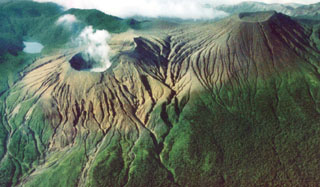Report on Rincon de la Vieja (Costa Rica) — February 1993
Bulletin of the Global Volcanism Network, vol. 18, no. 2 (February 1993)
Managing Editor: Edward Venzke.
Rincon de la Vieja (Costa Rica) Gas plumes rise to 500 m; lake level drops
Please cite this report as:
Global Volcanism Program, 1993. Report on Rincon de la Vieja (Costa Rica) (Venzke, E., ed.). Bulletin of the Global Volcanism Network, 18:2. Smithsonian Institution. https://doi.org/10.5479/si.GVP.BGVN199302-345020
Rincon de la Vieja
Costa Rica
10.8314°N, 85.3364°W; summit elev. 1729 m
All times are local (unless otherwise noted)
Fumarolic activity continued from the E wall of the active crater, with gas plumes rising 500 m. A strong smell of sulfur near the crater caused eye and skin irritation. Gas vents in the SE and SW parts of the crater had disappeared. Small collapses had occurred along the E and NE crater walls.
The level of the crater lake has dropped 1 m since last year. The light-gray colored lake had a temperature of 35°C in February and a pH of 1.6. The number of floating sulfur patches has decreased, and only one small bubbling area remains, producing very small intermittent bubbles.
Geological Summary. Rincón de la Vieja is a volcanic complex in the Guanacaste Range of NW Costa Rica. Sometimes referred to as the Rincon de la Vieja-Santa María Volcanic Complex, it consists of a slightly arcuate 20-km-long ridge of 12 craters and pyroclastic cones constructed within the 15-km-wide early Pleistocene Guachipelín caldera, whose rim is exposed on the south side. Sometimes known as the "Colossus of Guanacaste," it has an estimated volume of 130 km3 and contains at least nine major eruptive centers. The Santa María cone, the highest peak of the complex, is located on the E side of the ridge and has a lake within the 400-m-diameter crater. A Plinian eruption producing the 0.25 km3 Río Blanca tephra about 3,500 years ago was the last major magmatic eruption. All subsequent eruptions, including numerous reported eruptions possibly dating back to the 16th century, have been from the active crater, near the center of the complex, with an acidic 300-m-diameter lake.
Information Contacts: E. Fernández and J. Barquero, OVSICORI.

